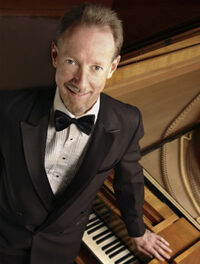Although the terms “big band” and “orchestra” are used interchangeably in the jazz context, the latter often implies a more eclectic approach to the music. The Maria Schneider Orchestra certainly fills the gap between jazz and classical music of the mid-twentieth century. While this concept is not novel, for example in the works of Igor Stravinsky and Gunther Schuller (see Tai Livingston’s website), Schneider cleverly illustrated this concept in her second piece of the evening, the dark “Don’t be Evil” (Schneider). This began as a slow jazz march tempo and gradually morphed into a carefully choreographed chaos (Evil!) under an energetic trombone solo from Tim Albright; the piece also featured North Carolina pianist Frank Kimbrough* playing a skillfully crafted solo with the whole ensemble ending the piece on a “hopeful note.”
The instrumental makeup of the orchestra is interesting in that it included an accordion in addition to the conventional rhythm section of piano, bass (the legendary and always tasteful Jay Anderson), drums (the rock solid and rhythmic anchor Jonathan Blake) as well as guitar (the classy Ben Monder) and a horn section of five reeds, four trumpets and four trombones. The accordionist Gary Versace added a particularly ethereal feeling to the first piece “Concert in the Garden” composed by Schneider. This won her a Grammy Award in 2004. (She has won 5 Grammys.)
Probably the most provocative piece of the evening was a work the Library of Congress commissioned her to write in 2016 entitled “Data Lords.” It is a piece that evokes the concept of artificial intelligence. Gradually building in intensity and volume, arrhythmic patterns evolved while being overlaid by trumpet and tenor saxophone solos from Brandon Lee and Rich Perry respectively – Arnold Schoenberg for jazz orchestra as it were! Finally, the piece resolved into a more serene conclusion with some delicate piano work from Kimbrough, including gentle massaging of the piano strings. In contrast to the “sonic orgies” referred to by composer Paul Hindemith, a delightful interlude was provided by Schneider’s ballad “Sanzenit” which she composed following a visit to a serene Garden of Peace in Japan.
Schneider’s work is often complex but nevertheless evocative. This was beautifully demonstrated in the piece “Arbiters of Evolution” from her award-winning recording The Thompson Fields. It is an epic work that featured highly varied solo sections for the tenor (Donny McCaslin) and baritone (Scott Robinson) saxophones in which they quietly emulated the birds-of-paradise species dancing (rock ‘n roll feel!); the piece evolves into a crescendo gradually adding other members of the orchestra. Schneider was not only the composer of most of the pieces in this concert, but she actually conducted her orchestra in quite a dramatic way, including dancing across the stage at times. Her tutelage under jazz giants, composer/arranger Gil Evans as well as trombonist Bob Brookmeyer and later a collaboration with David Bowie, certainly set the stage for this remarkable orchestra.
Naturally, the full-house enthusiastic audience on this cold and damp Saturday night expected an encore. Their wishes were fulfilled with a ballad “Equinox” based on the poems of fellow Minnesotan Ted Kooser. The piece had a gentle rock feel building up to a crescendo with a smooth and peaceful ending. To quote Schneider: “It’s uncanny how much these stunningly beautiful poems feel like home to me, connecting with my southwest Minnesota roots. There is nothing to explain about this music.”
*Full disclosure: this reviewer worked with Kimbrough when he was living in Chapel Hill in the 1970s.











